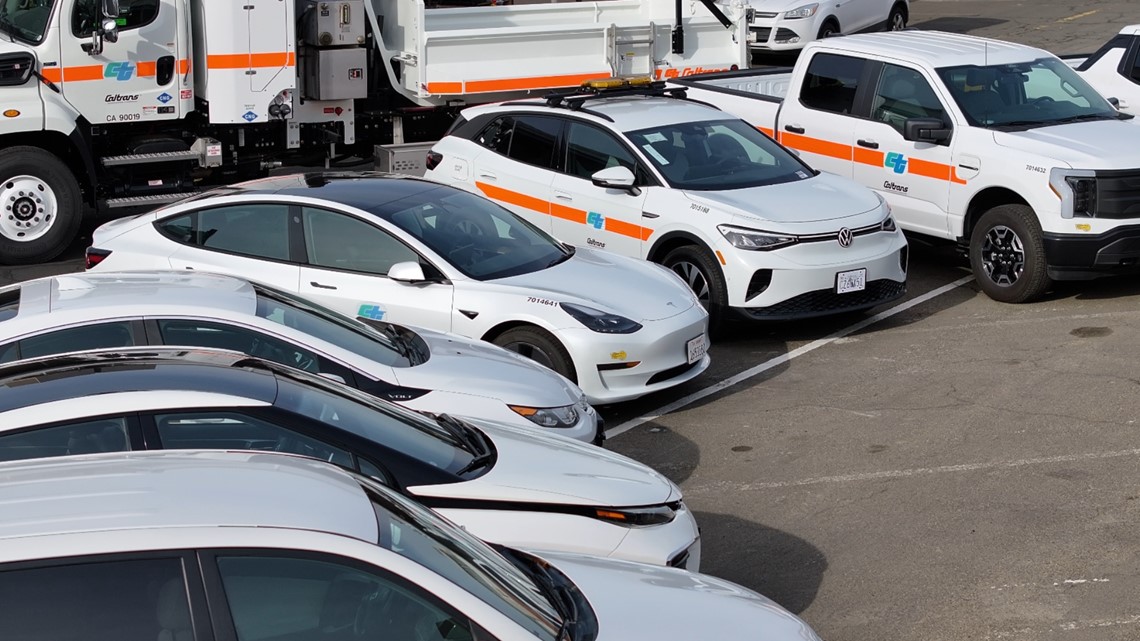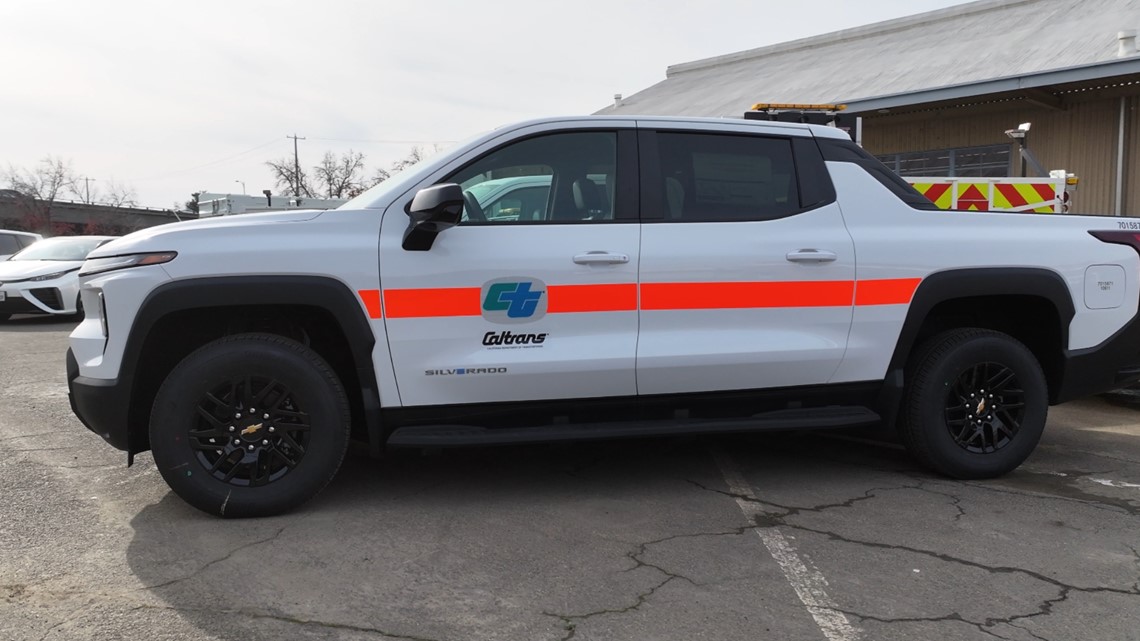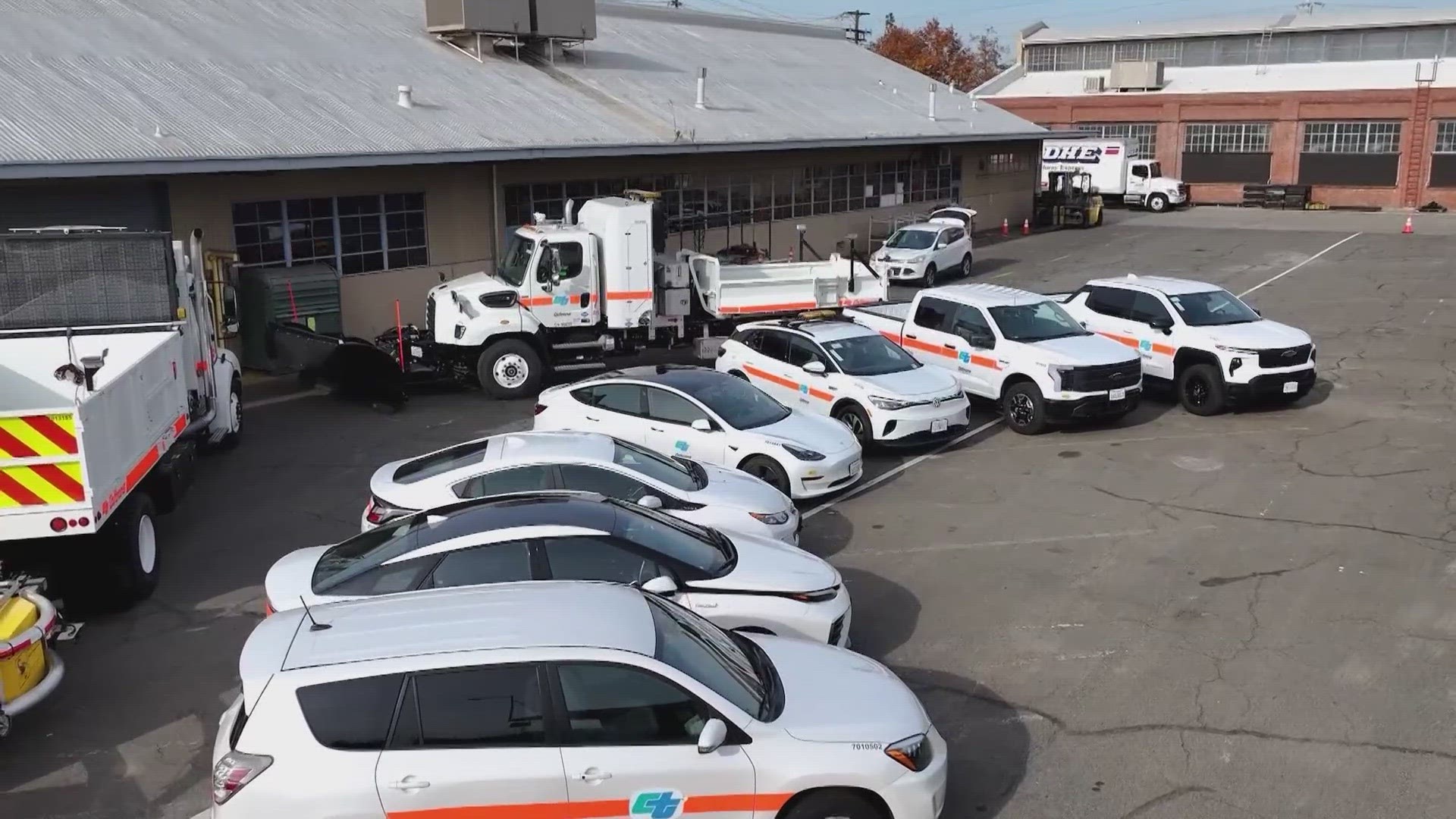SACRAMENTO, Calif. — In the middle of the pandemic, Governor Gavin Newsom announced new gas-powered cars couldn't be sold in California by 2035. It was a statement that shocked Californians and it's still causing debate.
Now, Caltrans is adding hundreds of Teslas to its fleet, but are they a good use of taxpayer dollars?
ABC10 went to Caltrans' main artery, the Division of Equipment in East Sacramento, to find the answer.
“We purchase, build, maintain and manage the entire Caltrans fleet," said Robert Myers, chief of Caltrans Division of Equipment, who oversees the fleet.
Myers explains how Caltrans began transitioning its sedans and SUVs to electric vehicles decades before Newsom's mandate. Caltrans purchased Toyota RAV4’s all the way back in the year 2000.
"Basically, it's what started our transition into EVs” said Myers.
According to Caltrans, its fleet consists of 12,000 vehicles and the goal is to be all electric by 2035. Right now, 5% of its fleet is meeting that goal and 399 of those vehicles are Teslas.
The Teslas were contracted to Caltrans in 2020, just days after state agencies were told to go all-electric. Myers confirmed Caltrans' Tesla purchase was the largest known EV fleet order from a government department.
But why is Caltrans purchasing electric cars, including Teslas, more than a decade away from the deadline?
"It takes a while to get there. You can't just flip the switch and say, 'I'm going to order 6,000 vehicles in a year,' because nobody can supply that many,” said Myers.
He says it comes down to three factors when purchasing fleet vehicles: state contracts, availability and cost.


Myers says Caltrans got a good deal on the Teslas, which cost them about $52,000 each. It totaled more than $20 million. ABC10 asked why Caltrans specifically purchased Teslas instead of other EVs.
"We did not want to specifically purchase Teslas, it was merely because they were available and they were on state contracts,” said Myers.
State contracts are handled by the Department of General Services (DGS). They help agencies purchase goods and services.
Through a public records request with DGS, ABC10 found there are 554 Tesla Model 3’s active in the state's fleet — Caltrans owns 399, the California Department of Food and Agriculture owns seven and is leasing 33, the California Department of Public Health is leasing 30 and the Department of Social Services is leasing 17.
ABC10 asked Caltrans if other companies presented contracts. Myers confirmed there were other contracts but some manufacturers didn’t have the volume to deliver the amount Caltrans needed.
"These days it's hard to get vehicles. You probably have seen some of the car lots out there. There's not very many new vehicles sitting on them and most people don't concentrate on fleet units, they concentrate on retail,” said Myers.
The 399 new Teslas will primarily be used for administrative staff to go to meetings and visit field locations. Due to the Tesla's 5-inch ground clearance, they can't be taken off road. When Caltrans cars have reached their life cycle, they are put up for auction and Caltrans gets the money back to reinvest into its fleet.
With many people across the state struggling due to inflation and the cost-of-living, ABC10 asked Caltrans what they believe taxpayers will think when seeing new Teslas in the fleet.
“Well, I'm hoping it says that Caltrans is leading the way. Because really what it comes down to is getting the volume of vehicles on the road, so that there's resale markets for them in the future. You don't see a lot of them right now and the prices are really high. If government and city and local entities are embracing this technology and move it forward, then it's going to lower the cost in the secondary market for all the people of California,” said Myers.
Right now, Caltrans' primary focus is on swapping what’s known as its light duty cars and SUVs for electric, but they’ve also been transitioning the larger fleet of cargo and plow trucks to greener alternatives.
"Caltrans has got a goal of being the greenest fleet in the nation,” said Myers.
It means they’ll be installing more EV chargers, but can California’s electric grid keep up? Myers says Caltrans is looking at some new technology including vehicle to grid, “where the battery packs actually will put power back into the grid,” but Myers says it's still being developed by vehicle manufacturers and startup companies.
California has had its share of rolling outages and natural disasters that have cut electric supply. If the lights do go out in California, Myers says Caltrans has generators and solar chargers in some locations.
A common environmental concern with EVs is batteries, partially because of the materials used to make them and how hard they are to recycle. Caltrans says it will not be recycling its batteries.
“What we're going to do is sell the vehicle and put it in the secondary market, so that other people can use them for longer. That's Caltrans' plan now,” said Myers.


Teslas weren't the only EVs Caltrans ordered. Its largest order of EVs was 600 Chevy Silverados. ABC10 got to see the first one Caltrans received at its Division of Equipment.
"What's unique is they concentrated on that market first, rather than retail, so that's a business decision they made and I'm happy for it because it's helping us out. It truly is a work truck, but it's all wheel drive, it's got 400-mile range,” said Myers.
Testing the Chevy Silverado batteries in different climates is also something Caltrans is working on. Myers' biggest concern is charging infrastructure because it’s currently slow but sustainable. Heading into the future it's vital to create charging access for not just Caltrans but residents throughout the state.
At the end of December 2023 the state released a budget letter stating it anticipates a significant budget deficit from the 2024 to 2025 fiscal year, meaning many departments will just have to cut back on non-essential spending, which includes fleet vehicles.
Myers says it's too early to tell what the impacts will be to Caltrans' zero emission goals and Caltrans will be waiting for direction from the administration. Caltrans is not currently making any fleet vehicle purchases.
Vehicle Makes and Models Approved for Purchasing From FY 2020-21 through FY 2022-23
Make / Models
- Chevrolet: Bolt, Colorado, Express, Express 2500, Express 3500, LCF 5500 XD, Lightning 6500 LCF, Silverado 1500, Silverado 2500, Silverado 3500, Silverado 4500, Silverado 5500, Silverado EV, Suburban, Tahoe, Traverse
- Chrysler: 300, Voyager
- Dodge: 1500, 2500, 3500, 5500, Charger, Durango
- Ford: Bronco, E350, E450, Escape, E-Transit, Expedition, Explorer, Explorer Interceptor/Utility, F-150, F-150 Lightning, F-250, F-350, F-450, F-550, F-650, F-750, Maverick, Ranger, Transit, Transit 150, Transit 250, Transit 350/350XL, Transit Connect, Transit XL
- Freightliner: 114SD, Cascadia, M2
- FSV: Coach Style 38 Mobile Command Center
- GMC: 7500
- HME: Aherns Fox
- Honda: Accord, Clarity, CR-V, Insight, Odyssey, Pilot
- Hyundai: Santa Fe, Tucson
- International: 4900, 7400, Bobtail Refrigerated Truck, CV, Durastar, HV, HX, MV
- Jeep: Grand Cherokee, Wrangler
- Kia: K5 GT
- Mack: 3-Axle Day Cab Tractor, Refuse Truck
- Mercedes: Sprinter Van
- Nissan: Armada, Murano, Pathfinder, Rogue
- Peterbilt: 389
- Ram: 1500, 2500, 3500, 5500
- Subaru: Outback
- Tesla: Model 3
- Toyota: 4Runner, Camry, Corolla, Highlander, Prius, Rav4, Sequoia, Sienna, Tacoma, Tundra
- Volkswagen: iD4 Pro, Passat
- Volvo: 3-axle Tractor, D-13, XC60
- Western Star: 4900
WATCH MORE ON ABC10: Study shows California electric vehicle rebates out of reach for marginalized people



















